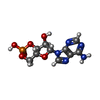+Search query
-Structure paper
| Title | Structures of the Human HCN1 Hyperpolarization-Activated Channel. |
|---|---|
| Journal, issue, pages | Cell, Vol. 168, Issue 1-2, Page 111-120.e11, Year 2017 |
| Publish date | Jan 12, 2017 |
 Authors Authors | Chia-Hsueh Lee / Roderick MacKinnon /  |
| PubMed Abstract | Hyperpolarization-activated cyclic nucleotide-gated (HCN) channels underlie the control of rhythmic activity in cardiac and neuronal pacemaker cells. In HCN, the polarity of voltage dependence is ...Hyperpolarization-activated cyclic nucleotide-gated (HCN) channels underlie the control of rhythmic activity in cardiac and neuronal pacemaker cells. In HCN, the polarity of voltage dependence is uniquely reversed. Intracellular cyclic adenosine monophosphate (cAMP) levels tune the voltage response, enabling sympathetic nerve stimulation to increase the heart rate. We present cryo-electron microscopy structures of the human HCN channel in the absence and presence of cAMP at 3.5 Å resolution. HCN channels contain a K channel selectivity filter-forming sequence from which the amino acids create a unique structure that explains Na and K permeability. The voltage sensor adopts a depolarized conformation, and the pore is closed. An S4 helix of unprecedented length extends into the cytoplasm, contacts the C-linker, and twists the inner helical gate shut. cAMP binding rotates cytoplasmic domains to favor opening of the inner helical gate. These structures advance understanding of ion selectivity, reversed polarity gating, and cAMP regulation in HCN channels. |
 External links External links |  Cell / Cell /  PubMed:28086084 / PubMed:28086084 /  PubMed Central PubMed Central |
| Methods | EM (single particle) |
| Resolution | 3.5 - 3.51 Å |
| Structure data | |
| Chemicals |  ChemComp-CMP: |
| Source |
|
 Keywords Keywords | TRANSPORT PROTEIN / pacemaker ion channel |
 Movie
Movie Controller
Controller Structure viewers
Structure viewers About Yorodumi Papers
About Yorodumi Papers







 homo sapiens (human)
homo sapiens (human)